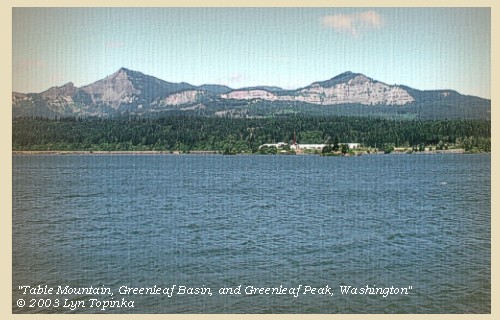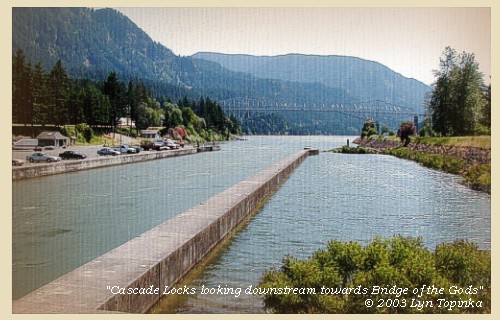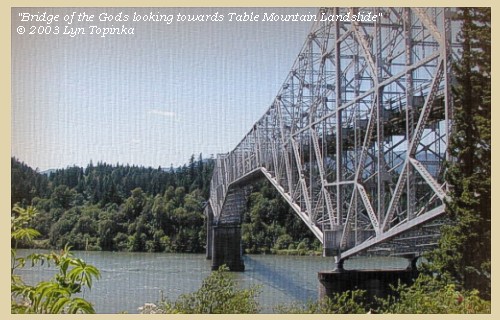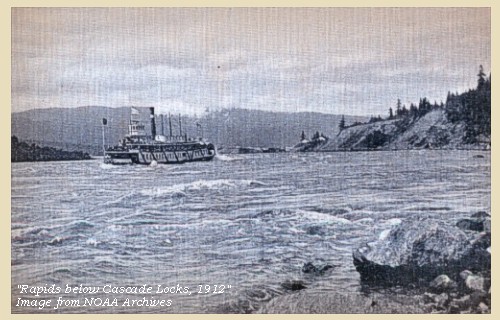The Volcanoes of
Lewis and Clark
Lewis and Clark
|
October 31, 1805 "Lower Falls of the Columbia" - Cascade Locks - Preparing to Portage |
|
Home
The Volcanoes of Lewis and Clark Map of the Journey Volcanoes, Basalt Plateaus, Major Rivers, etc. The Volcanoes Mount Adams, Mount Hood, Mount Jefferson, Mount Rainier, and Mount St. Helens CALENDAR of the Journey October 1805 to June 1806 Along the Journey Pacific Northwest Maps - Columbia River, Volcanoes, Flood Basalts, Missoula Floods, Geology, etc. The Corps of Discovery The Journey of Lewis and Clark About the Reference Materials The Journals, Biddle/Allen, DeVoto, Gass, Moulton, Topo Maps, and others USGS Lewis and Clark Links Links to USGS Websites highlighting the Lewis and Clark Journey Resources Publications Referenced and Websites Visited |
PREVIOUS
October 30 Dog Mountain to Cascade Locks |
October 31
"Lower Falls of the Columbia", Cascade Locks - Preparing to Portage Bonneville Landslide, "Lower Falls of the Columbia" and the Cascade Locks, Bridge of the Gods, Rapids below Bridge of the Gods |
CONTINUE
November 1 Columbia River Gorge, Cascade Locks to Bonneville - The Portage |
|
To the Pacific - October 1805
"Lower Falls of the Columbia" - Cascade Locks - Preparing to Portage |
| The Lewis and Clark camp of October 30 and 31, 1805 was on an island on the Washington side of the Columbia River, just north of today's Cascades Locks and Bridge of the Gods. The island is now under the waters of Bonneville Dam. The men portaged across this "Lower Falls of the Columbia" on November 1, 1805. |
| Thursday, October 31, 1805 |
| "... The morning was cloudy. We unloaded our canoes and took them past the rapids, some part of the way by water, and some over rocks 8 or 10 feet high. It was the most fatiguing business we have been engaged in for a long time, and we got but two over all day, the distance about a mile, and the fall of the water about 25 feet in that distance. ..." [Gass, October 31, 1805] |
| He [Captain Clark] resumed his search in the morning, through the rain. [looking at portage around the Bonneville Landslide] At the extremity of the basin, in which is situated the island where we are encamped [today the island is underwater], several rocks and rocky islands are interspersed through the bed of the river. The rocks on each side have fallen down from the mountains [Bonneville Landslide]; that on the left being high [Oregon], and on the right the hill itself, which is lower [Table Mountain and Greenleaf Peak], slipping into the river; so that the current is here compressed within a space of one hundred and fifty yards. |
| Within this narrow limit it runs for the distance of four hundred yards with great rapidity, swelling over the rocks with a fall of about twenty feet: it then widens to two hundred paces, and the current for a short distance becomes gentle; [In 1926 the Bridge of the Gods was constructed below the "falls".] |
| but at the distance of a mile and a half, and opposite to the old village mentioned yesterday, it is obstructed by a very bad rapid [below Bridge of the Gods] , where the waves are unusually high, the river being confined between large rocks, many of which are at the surface of the water. |
| Captain Clarke proceeded along the same path he had taken before, which led him through a thick wood and along a hill side, till two and a half miles below the shoots, he struck the river at the place whence the Indians make their portage to the head of the shoot: he here sent Crusatte, the principal waterman, up the stream, to examine if it were practicable to bring the canoes down the water. In the meantime, he, with Joseph Fields, continued his route down the river, along which the rapids seem to stretch as far as he could see. |
| "... I proceeded down the river to view with more attention we had to pass on the river below, the two men with me Jo. Fields & Peter Crusat proceeded down to examine the rapids the Great Shute which commenced at the Island on which we encamped Continued with great rapidity and force thro a narrow chanel much compressd. and interspersed with large rocks for 1/2 a mile, at a mile lower is a verry Considerable rapid at which place the waves are remarkably high, and proceeded on in an old Indain parth 2 1/2 miles by land thro a thick wood & hill Side, to the river where the Indians make a portage, from this place I Dispatched Peter Crusat (our principal waterman) back to follow the river and examine the practibility of the Canoes passing, as the rapids appear to continue down below as far as I could See ..." [Clark, October 31, 1805] |
| At half a mile below the end of the portage [the portage was across the Bonneville Landslide], he came to a house, the only remnant of a town, which, from its appearance, must have been of great antiquity. The house was uninhabited, and being old and decayed, he felt no disposition to encounter the fleas, which abound in every situation of that kind, and therefore did not enter. About half a mile below this house, in a very thick part of the woods, is an ancient burial place: it consists of eight vaults ...... After examining this place captain Clarke went on, and found the river as before strewed with large rocks, against which the water ran with great rapidity. Just below the vaults the mountain, which is but low on the right side, leaves the river, and is succeeded by an open stony level, which extends down the river, while on the left the mountain is still high and rugged. At two miles distance he came to a village of four houses, which were now vacant and the doors barred up: on looking in he saw the usual quantity of utensils still remaining, from which he concluded that the inhabitants were at no great distance collecting roots or hunting, in order to lay in their supply of food for the winter: he left them and went on three miles to a difficult rocky rapid, which was the last in view. Here, on the right, are the remains of a large and ancient village, which could be plainly traced by the holes for the houses and the deposits for fish: after he had examined these rapids and the neighbouring country he returned to camp by the same route: ...... |
| "... from a Short distance below the vaults the mountain which is but low on the Stard. Side, leave the river, and a leavel Stoney open bottom Suckceeds on the Said Std. Side for a great Distance down, the mountains high and rugid on the Lard. Side this open bottom is about 2 miles a Short distance below this village is a bad Stoney rapid and appears to be the last in view I observed at this lower rapid the remains of a large and antient Village which I could plainly trace by the Sinks in which they had formed their houses, as also those in which they had buried their fish -- from this rapid to the lower end of the portage the river is Crouded with rocks of various Sizes between which the water passes with great velociety createing in maney places large Waves, an Island [Bradford Island, see entry of November 1, 1805] which is Situated near the Lard. Side occupies about half the distance the lower point of which is at this rapid. immediately below this rapid the high water passes through a narrow Chanel through the Stard. Bottom forming an Island of 3 miles (wide) Long & one wide, I walked through this Island which I found to be verry rich land, and had every appearance of haveing been at Some distant period Cultivated. at this time it is Covered with grass intersperced with Strawberry vines [Hamilton Island, see entry of November 2, 1805] . I observed Several places on this Island where the nativs had dug for roots and from its lower point I observed 5 Indians in a Canoe below the upper point of an Island near the middle of the river Covered with tall timber, which indued me to believe that a village was at no great distanc below, I could not See any rapids below in the extent of my view which was for a long distance down the river, which from the last rapids widened and had everry appearance of being effected by the tide, -- I deturmind to return to Camp 10 miles distant, a remarkable high detached rock Stands in a bottom on the Stard. Side near the lower point of this Island on the Stard. Side about 800 feet high and 400 paces around, we call the 'Beaten rock'. [Beacon Rock, see entry of November 2, 1805] A Brook falls into the narrow Chanel which forms the Strawberry Island, which at this time has no running water, but has every appearance of dischargeing emence torrents &c. &c. ..." [Clark, October 31, 1805] |
| "... This Great Shute or falls is about 1/2 a mile, with the water of this great river Compressed within the Space of 150 paces in which there is great numbers of both large and Small rocks, water passing with great velocity forming & boiling in a most horriable manner, with a fall of about 20 feet, below it widens to about 200 paces and current gentle for a Short distance, a Short distance above is three Small rockey Islands, and at the head of those falls, three Small rockey Islands are Situated Crosswise the river, Several rocks above in the river & 4 large rocks in the head of the Shute; those obstructions together with the high Stones which are continually brakeing loose from the mountain on the Stard Side and roleing down into the Shute aded to those which brake loose from those Island above and lodge in the Shute, must be the Cause of the rivers daming up to Such a distance above, (and Show) where it Shows Such evidant marks of the Common current of the river being much lower than at the present day ..." [Clark, October 31, 1805] |
| In the meantime we had been occupied in preparations for making the portage, and in conference with the Indians, who came down from the village to visit us. ...... |
|
|
|
The Camp - October 30 and 31, 1805:
The Lewis and Clark camp of October 30 and 31, 1805, was on an island on the Washington side of the Columbia River, just north of today's Bridge of the Gods. This area is today known as Cascade Locks. The island is now under the waters of Bonneville Dam. |
| Home | Previous | Continue |
If you have questions or comments please contact: GS-CVO-WEB@usgs.gov
June/July 2004, Lyn Topinka
The Volcanoes of Lewis and Clark Home Page | CVO Home Page

























